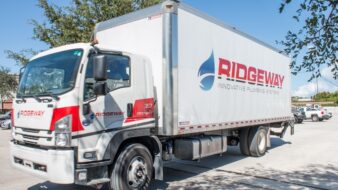In Pennsylvania, poultry is the state’s biggest agricultural business. And that means giant piles of bird waste: manure. Typically, farmers spread it on the fields.
Chicken farmer Earl Ray Zimmerman was exploring ways to increase his farm’s sustainability and profitability. At the same time, a local energy-solutions company was putting the pieces together for a heating system plan that would take the need for heat, and the need to dispose of manure, and cancel them both out.

The manure burning heating system fits well with the overall sustainability theme Zimmerman has applied to his organic farm.
Not too long ago, Zimmerman’s two, 500-foot long chicken houses were entirely heated by direct-combustion unit heaters.
Today, with state-of-the-art, bio-fueled hydronic technology, he’s burning chicken manure instead.
Chicken manure contains roughly 3,500 BTUs per pound,” said Matt Aungst, co-owner of Total Energy Solutions, LLC in Willow Street, PA, the company behind the entire design of the heating system.

System designers, Matt Aungst and John Albright stand next to their brainchild. The heating solution depends upon the ability to precisely monitor flow rates via Taco KV series sensorless pumps with variable frequency drives.
Over several months, TEC designed a system that would burn manure to fire a large hydronic system that serves both large chicken houses.
“For this project, we teamed up with two companies who lead their markets in craftsmanship and ingenuity,” continued Aungst. “Farmer Boy Ag Supply, in Myerstown, PA, provided installation talent, and Taco Inc., in Cranston, RI, provided the engineering brainpower to get the BTUs where they need to be with Taco KV series of SelfSensing pumps.”

From any web-enabled device, Zimmerman can make extremely precise changes to the temperature within the houses. The Danfoss PICV (pressure independent control valves) modulate to a specific flow rate, and the sensorless Taco pumps in the mechanical room change speed accordingly.
One chicken house can call for up to 600 MBH at any given time, but an average heat load in the winter is likely to be around 200-300MBH per house. At the center of the new hydronic system is a 1.5 million BTU, manure-burning boiler. The system was designed and engineered to provide 100% of the heat load.
The boiler is the size of a service van, and occupies its own remote building. An auger feeds dry manure from the hopper into the boiler, which doesn’t produce strong odors or much smoke.
The heart of the distribution system is also in the mechanical building. Two redundant VFD-powered Taco SelfSensing pumps are plumbed in parallel. Three-inch PEX water lines run 300 feet to a distribution manifold between the two chicken houses. The new Taco SKV3009 SelfSensing pumps accurately respond to changes in system demand without the need for pressure sensors.
Inside each chicken house, eight CUBO unit-heaters hang from the ceiling, providing the water-to-air heat exchange. The units are designed exclusively for the poultry industry and provide air mixing, destratification, and lateral heat distribution.

Matt Aungst, who designed the distribution portion of the project tests redundancy of the only two pumps on the entire project. Pump A runs as “duty”, leaving pump B for backup. After 84 hours of run-time, the pumps automatically switch roles.
Each one of these unique unit heaters has its own Danfoss PICV (pressure independent control valve). The PICVs act as variable zone valves, with the ability to modulate flow depending on the temperature at the nearest thermistor.
But the PICVs and CUBOs need a circulation system that’s compatible. The Taco pumps react to the specific call for water — regardless of the number of valves calling or how far open the valves are.

John Albright, of Total Energy Solutions, LLC, and chicken farmer Earl Zimmerman watch the biofuel boiler cycle.
The seven-and-a-half horsepower pumps are each programmed to supply a maximum of 125 GPM at 85 feet of head. According to Jeff Pitcairn, Taco’s commercial regional manager, pump A runs as “duty,” leaving pump B for backup. After 84 hours of run-time, the pumps automatically switch roles.

Left to right – Matt Aungst and John Albright, owners of Total Energy Solutions, LLC, in Willow Street, Pennsylvania, designed the hydronic biofuel system that now serves two chicken houses at Zimmerman’s farm.
According to Zimmerman, chickens are extremely temperature sensitive. In a chicken house, even a 10°F drop for an hour could seriously affect his bottom line. The SelfSensing pumps, PIC valves and CUBO unit heaters work harmoniously to deliver the exact temperature needed, 24/7/365.

There’s little doubt that Zimmerman’s installation achieves energy savings, heat distribution and farm production benefits that surpass any other hydronic poultry heating system available.
And now, as Americans learn more about the impact of a national bird flue epidemic that’s forced higher prices for all poultry products, Zimmerman’s fighting back with smarter systems that have the ability to produce more food with less cost and lower environmental impact. That’s smart farming.
Boiler — Blue Flame Stoker, 1.5 MMBTU
Design software — Taco HSS
Radiation — CUBO unit heaters
Pumps — Taco KV SelfSensing
PIC valves — Danfoss
Balancing valves — Taco Plus Two valves
PEX — Logstor
Expansion tank — Taco, 125 gallon
Air separator — Taco 4903




Join the conversation: